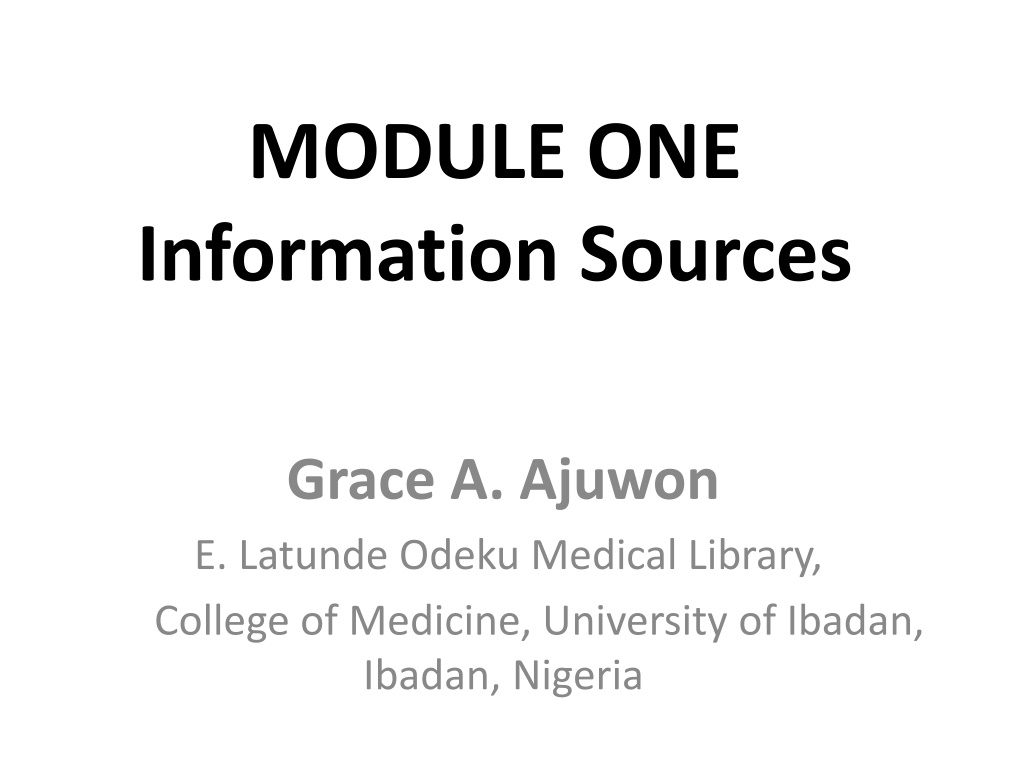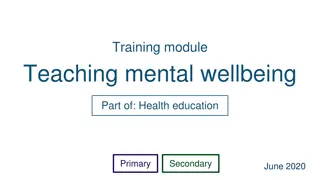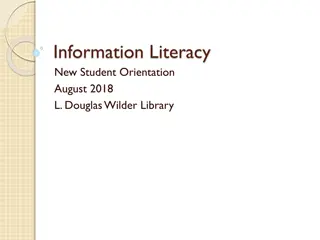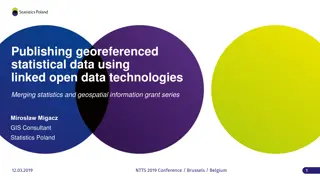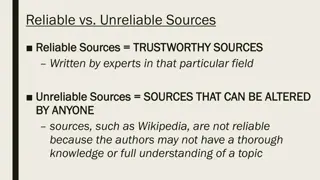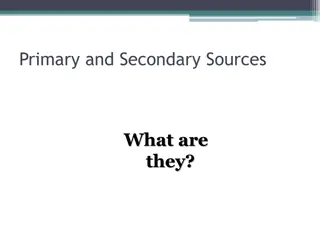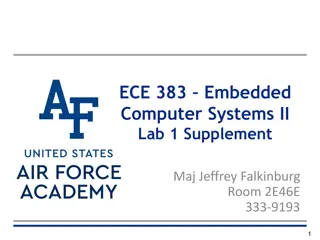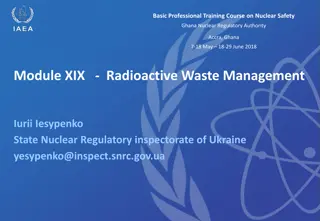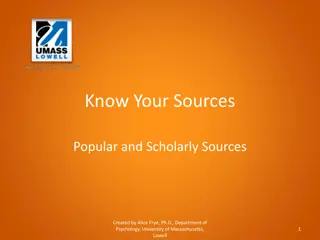Understanding Information Sources: A Comprehensive Module
Delve into the world of information sources through this module that explores the definition, creators, types, formats, locations, categories, and internet sources of information. Enhance your knowledge for academic and practical applications.
Download Presentation

Please find below an Image/Link to download the presentation.
The content on the website is provided AS IS for your information and personal use only. It may not be sold, licensed, or shared on other websites without obtaining consent from the author. Download presentation by click this link. If you encounter any issues during the download, it is possible that the publisher has removed the file from their server.
E N D
Presentation Transcript
MODULE ONE Information Sources Grace A. Ajuwon E. Latunde Odeku Medical Library, College of Medicine, University of Ibadan, Ibadan, Nigeria
Overview Introduction What are information sources? Producers/creators of information sources Types of information sources Formats of information sources Where to find information sources Categories of information sources Internet information sources
Introduction Information is an essential ingredient in decision making and useful in our daily lives Timely, up-to-date, relevant and quality information is vital for academic purposes and for patient care This module is expected to deepen your knowledge about the sources of information
Learning Objectives In this module, you would learn: The definition of information sources The major producers/creators of information sources Types of information sources The formats of information sources Where to find information sources The categories of information sources Internet information sources
Learning Outcomes At the end of this module you should be able to: Define information sources Identify and list the producers/creators of information Determine types and formats of information sources Determine where to find information sources List and discuss the categories of information sources Identify and use Internet information sources
Table 1: Content, Teaching Methods and Mode of Assessment Content Methods Mode of Assessment S/N 4.1 Definition of information/ information sources Brainstorming Discussion Lecture Question and Answers Lecture Brain storming Producers and originators of information sources Question and Answers 4.2 Types of information sources Brainstorming Discussion Question and Answers 4.3 Brainstorming Discussion Lecture Formats of information sources Pre and post test 4.4 Where to find sources of information Brain storming Discussion Question and Answer 4.5 Categories of information sources Brainstorming Discussion Lecture Brainstorming Lecture Question and Answers 4.6 Assignment Internet information sources Question and Answers Hands- on 4.7
What are information sources? Information sources are the various means by which information is recorded for use by an individual or organization These are means by which a person is informed about something or knowledge is provided or share with someone, a group of people or an organization Information sources could be observations, people, organizations, speeches, documents, pictures, art work Information sources could be in print or non-print formats.
Producers/Creators of Information Sources There are three main producers/creators of information. These are: Government Departments Agencies Ministries Private Sector Private Individuals Not for profit organizations For profit organizations and commercial agencies International Agencies Professional Associations or organizations Private institutions Corporate bodies and laboratories Academic/Research Institutions colleges Universities Research institutes
Types of Information Sources The three types of information sources are: Primary Secondary Tertiary
Primary Sources of Information Are usually evidence or accounts of the events, practices, or conditions being researched Present information in its original form, not interpreted or condensed or evaluated by other writers Are created by a person (s) who directly experienced that event Example include among others Diaries, interviews, minutes of meetings, photographs, videos, artworks, artifacts However, what constitute a primary source of information depends on the disciple or context (how the material is used)
Secondary Sources of Information A secondary source of information is one that was created by someone who did not have a first-hand experience or participate in the events being researched Are generally accounts written after the fact with the benefit of hindsight Secondary sources describe, analyze, interpret, evaluate, comment on and discuss the evidence provided by primary sources They are not evidence, but rather commentary on and discussion of evidence A secondary data is one that has been collected by individuals or agencies for purposes other than those of a particular research study Examples are: textbooks, bibliographies, biographical works, commentaries, criticisms, dictionaries, encyclopedias What constitutes a secondary source of information depends on disciple or how the information is used
Tertiary Sources of Information These are works which list primary and secondary resources in a specific subject area Materials that index, organize and compile citations to, and show how secondary (and sometimes primary) sources could be used These are materials in which information from secondary sources has been "digested" - reformatted and condensed, and put into a convenient, easy-to-read form Examples include: almanacs, directories, population registers/ statistics, fact books, abstracts, indexes, bibliographies, chronologies, classifications, handbooks, guide books and manuals,
Difference b/w Primary, Secondary and Tertiary sources Primary sources of information are original manuscripts, documents or records used in preparing a published or unpublished work For example, an original piece of art work will be considered a primary source Secondary sources are published or unpublished works that relies on primary source(s) An article critiquing a piece of art work would be a secondary source Tertiary sources are published or unpublished works that is based on secondary sources. An art index would be considered a tertiary source It is sometimes difficult to differentiate between primary, secondary and tertiary sources
Formats of Information Sources Information is of great diversity and in various formats The two main formats are: Print Books, periodicals, bibliographies, maps, indexes and abstracts, photographs, government documents, technical reports, etc Non-print audio visual, multimedia, microform and electronic books and journals, images, texts/records from the Internet, Web documents, etc
Where to Find Information Sources Information could be obtained from: Human sources Archives Library Internet
Human Sources Communication with peers / colleagues are a good way of obtaining vital information For example, doctors have been found to rely on their colleagues for information in order to solve a patient s problems Informal sources of information are valuable and are readily available If the right person is contacted, quality and up-to date information will be obtained There may be some elements of bias in the information provided by human sources Individuals may say provide information from their own point of view or exaggerate it.
Archives Archives are places where records of all types and formats are kept and made accessible for research and other purposes Archives store, preserve and make accessible records of enduring value, unique and usually one of its kind items They are a good place to find both published and unpublished primary sources Personal and institutional records of all types can be found in archives, as well as media, ephemera, oral histories, and even artifacts Archival materials are rare and irreplaceable as a result they are not on loan
Libraries Libraries collect quality information in a wide variety of formats Librarians select books, journals, magazines, databases, CDs, DVDs, government reports for use by their patrons This selection process enables libraries to collect resources considered to be reliable, relevant and valuable Library materials unlike those found on the Internet go through a review process Libraries provide access to reference resources, books, periodicals and other materials in both print and electronic formats for use by the patrons Some libraries specialize in information materials like rare books, maps, unpublished manuscripts and other special collections Some library materials can be loaned to users
Internet The Internet is a network of computer networks around the world that enable people to access information and to communicate with each other The World Wide Web (WWW) provides the technology needed to navigate the resources on the Internet No innovation in history has so profoundly changed our lives as the Internet (Blonde, Cook and Dey, 1999)
Types of Information on the Internet The Internet contains all kinds of information sources including among others: Bibliographic information such as library catalogs Monographs Reference sources such as Encyclopedias, Dictionaries, Handbooks, etc. Indexes and abstracts Drug information sources (e.g. MICROMEDEX) Journals, Magazines, Newspapers Databases Multimedia: Audio, video and graphical sources of information Grey literature (technical reports, government documents, thesis/dissertations, etc Subject related gateways, portals and digital/institutional repositories (eg. HINARI)
Databases Bibliographic databases African Index Medicus (AIM) MEDLINE/PubMed Cumulative Index to Nursing and Allied Health Literature (CINAHL) Web of Knowledge Scopus EMBASE Consumer Health Information MEDLINEPlus National Institute of Health (NIH) Senior Health New York Online Access to Health (NOAH) HealthyRoadsMedia Toxtown Toxnet Household products database Evidence based Medicine databases Clinical Queries Cochrane Library Clinical Evidence DynaMed Best Evidence
Internet Portals, Digital Archives and Institutional Repositories Health Internetwork Access to Research Initiative (HINARI) http://www.who.int/hinari African Journals Online (AJOL) http://ajol.info PubMed Central (PMC): http://www.ncbi.nlm.nih.gov/pmc/ Bioline International (BI): Through this site you can search through free and open access medical journals at http://www.bioline.org.br/is Biomed Central: Open Access (OA) journal publisher that allow readers free access to published full text journal articles while authors pay fees to get published. http://www.biomedcentral.com/browse/journals/ Scientific Online Library (SciELO): An AO publisher that gives access to full text articles. http://www.scielo.org.ar/scielo.php?lng=en Directory of Open Access Journals (DOAJ): Gives you free access to online journals related to your subject area. You can access the site at http://www.doaj.org/doaj?func=findJournals Loughborough University s Institutional Repository http://www.lboro.ac.uk/library/resources/InstitutionalRepository.html
Information Sources on Social Networking Applications Social networking applications (Web 2.0) are now been used as a means of communication, sharing and dissemination of information Libraries are also using this media to reach out to their clients Common Web 2.0 applications that have become sources of information include: Facebook Blogs Myspace RSS Twitter U-Tube
References http://cptra.In.edu.hk/~bus110/041st/notes/M02-notes.doc Retrieved Jan 8, 2011 Introduction to information literacy: Information needs and sources. http://www-public.jcu.edu.au/libcomp/resources/era/JCUPRD_026231 Retrieved Jan. 8, 2011 Primary, secondary and tertiary sources. James Cook University Libraries. Information sources: Primary, Secondary, Tertiary and Grey literature. Florida Gulf Coast University. http://library.fgcu.edu/RSD/Instruction/handouts/handout-primary_secondary.pdf Retrieved Jan. 16, 2010 Primary, secondary and tertiary sources. University of Wisconsin Library-Steven Point. http://library.uwsp.edu/guides/webtutirials/primary.htm Retrieved Jan 1 2, 2011. Primary secondary and tertiary sources, Finnish Institutions Research Paper (Hopkins), Department of Translation Studies, University of Tampere http://www.uta.fi/FAST/FIN/RESEARCH/sources.html What are primary sources: finding primary sources. California State University Library, Los Angeles. http://www.calstatela.edu/library/guides/pswhat.htm retrieved Jan. 5, 2011 Primary vs. secondary sources. University of Victoria Libraries. http://library.uvic.ca/site/lib/instruction/research/primvsec.html Retrieved Jan. 6, 2011
References Conts. Guides to information sources; primary, secondary and tertiary. University Libraries, University of Maryland. http://www.lib.umd.edu/guides/primary-sources.html Virtual Information Literacy Learning and Growing Environment (VILLGE), University of Illinois Library, University of Illinois, Urbana Champaign http://www.library.illinois.edu/village/primarysource/mod1/pg1.htm http://www.library.illinois.edu/village/primarysource/mod2/pg1.htm Department of Translation Studies, University of Tampere http://www.uta.fi/FAST/FIN/RESEARCH/sources.html Primary secondary and tertiary sources, Finnish Institutions Research Paper (Hopkins), What are primary sources: finding primary sources. California State University Library, Los Angeles. http://www.calstatela.edu/library/guides/pswhat.htm retrieved Jan. 5, 2011 Primary vs. secondary sources. University of Victoria Libraries. http://library.uvic.ca/site/lib/instruction/research/primvsec.html Retrieved Jan. 6, 2011 What is Microfilm. Nz Micrographics. http://www.micrographics.co.nz/nzmicrographics/NZMSMICRO/WHATISMICROFILM/tabid/241/Default.aspx Retrieved Jan 18, 2011 18, 2011 17. What is microfilm. WiseGeek. http://www.wisegeek.com/what-is-microfilm.htm Retrieved Jan. 18, 2011 18. What is Microfiche? WiseGee. http://www.wisegeek.com/what-is-microfiche.htm Retrieved Jan.
